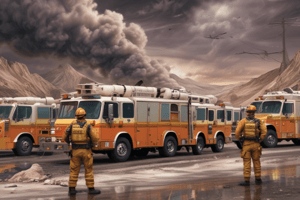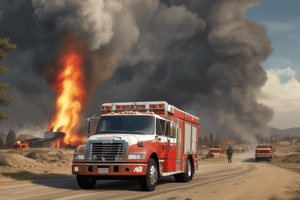Podcast
Questions and Answers
In Incident Command System (ICS), which of the following best describes the role of Emergency Medical Services?
In Incident Command System (ICS), which of the following best describes the role of Emergency Medical Services?
- To bypass the ICS system when dealing with pediatric patients to expedite treatment.
- To operate independently of the ICS structure to ensure rapid patient care.
- To function within the ICS system, adhering to its structure and protocols. (correct)
- To assume overall command of the incident regardless of the agencies involved.
In the context of Incident Command System (ICS), what does the concept of 'Unity of Command' primarily ensure?
In the context of Incident Command System (ICS), what does the concept of 'Unity of Command' primarily ensure?
- All personnel report to multiple supervisors to foster collaboration.
- Each individual reports to only one designated supervisor. (correct)
- Incident commanders from different agencies operate independently.
- Resources are allocated without regard to organizational structure.
During a mass casualty incident (MCI), what is the primary objective of the Incident Command System (ICS)?
During a mass casualty incident (MCI), what is the primary objective of the Incident Command System (ICS)?
- To focus solely on the needs of first responders, regardless of patient status.
- To allow freelancing; uncontrolled actions by responders to expedite patient care.
- To bypass standard protocols to ensure the fastest possible response times.
- To manage the incident by eliminating duplication of effort and controlling freelancing. (correct)
What is the significance of 'Span of Control' in the Incident Command System?
What is the significance of 'Span of Control' in the Incident Command System?
In Incident Command, what is the role of the 'Chain of Command'?
In Incident Command, what is the role of the 'Chain of Command'?
Who typically assumes the role of Incident Commander (IC) at the start of an incident?
Who typically assumes the role of Incident Commander (IC) at the start of an incident?
What is a key responsibility of the Incident Commander (IC)?
What is a key responsibility of the Incident Commander (IC)?
What is the primary responsibility of the Safety Officer in Incident Command?
What is the primary responsibility of the Safety Officer in Incident Command?
Which of the following is a key component of EMS Incident Command System (ICS)?
Which of the following is a key component of EMS Incident Command System (ICS)?
Within the EMS Incident Command System, what is the main goal of medical treatment operations?
Within the EMS Incident Command System, what is the main goal of medical treatment operations?
What is the role of the EMS Branch within Incident Command?
What is the role of the EMS Branch within Incident Command?
What is a primary responsibility of the Triage Officer?
What is a primary responsibility of the Triage Officer?
How does the approach to triage change during a large-scale incident compared to a normal incident?
How does the approach to triage change during a large-scale incident compared to a normal incident?
What is the role of the Treatment Officer within the Incident Command System?
What is the role of the Treatment Officer within the Incident Command System?
What action is a Treatment Officer most likely to take when one area becomes overwhelmed with patients?
What action is a Treatment Officer most likely to take when one area becomes overwhelmed with patients?
What is the role of the Transportation Officer in the EMS Incident Command System?
What is the role of the Transportation Officer in the EMS Incident Command System?
Why is scene size-up important?
Why is scene size-up important?
What information is commonly included in an MVA Initial Radio Report?
What information is commonly included in an MVA Initial Radio Report?
Which of the following is a critical element to include in a Fire Initial Radio Report?
Which of the following is a critical element to include in a Fire Initial Radio Report?
A motor vehicle accident with minor damage, such as broken headlights and components behind the bumper would be defined as what?
A motor vehicle accident with minor damage, such as broken headlights and components behind the bumper would be defined as what?
A motor vehicle accident with visible damage that affects the vehicles normal operations would be defined as what?
A motor vehicle accident with visible damage that affects the vehicles normal operations would be defined as what?
A motor vehicle accident that causes serious injuries, fatalities, or significant property damage would be defined as what?
A motor vehicle accident that causes serious injuries, fatalities, or significant property damage would be defined as what?
According to the RAMP triage, what is the significance of assessing whether a patient follows commands?
According to the RAMP triage, what is the significance of assessing whether a patient follows commands?
In RAMP triage, what is the first action performed on a patient?
In RAMP triage, what is the first action performed on a patient?
According to the RAMP Triage, what is the last action to take on a patient?
According to the RAMP Triage, what is the last action to take on a patient?
What does 'INA' stand for in the context of treatment sectors at the scene of a mass casualty incident?
What does 'INA' stand for in the context of treatment sectors at the scene of a mass casualty incident?
What type of trauma center should patients with a RR < 10 or > 29 breaths/min be transported to?
What type of trauma center should patients with a RR < 10 or > 29 breaths/min be transported to?
What type of trauma center should children, age 0-9 years, that were unrestrained during an MVA be transported to?
What type of trauma center should children, age 0-9 years, that were unrestrained during an MVA be transported to?
What course does the EMS incident Command System NOT satifsy?
What course does the EMS incident Command System NOT satifsy?
Which of the following would be considered a modern disaster?
Which of the following would be considered a modern disaster?
What functional roles does the EMS Branch discuss?
What functional roles does the EMS Branch discuss?
What must apply to routine emergency calls?
What must apply to routine emergency calls?
Flashcards
Mass Causality Incident (MCI)
Mass Causality Incident (MCI)
An event where the number of patients exceeds available initial responder resources.
Unified Command (UC)
Unified Command (UC)
A structure uniting incident commanders from different organizations to coordinate a response.
Optimal Span of Control
Optimal Span of Control
The ideal number of subordinates one leader effectively manages is 5.
Chain of Command
Chain of Command
Signup and view all the flashcards
Incident Commander (IC)
Incident Commander (IC)
Signup and view all the flashcards
Safety Officer
Safety Officer
Signup and view all the flashcards
Key EMS ICS Components
Key EMS ICS Components
Signup and view all the flashcards
EMS Branch Responsibilities
EMS Branch Responsibilities
Signup and view all the flashcards
Triage Officer
Triage Officer
Signup and view all the flashcards
Triage
Triage
Signup and view all the flashcards
Treatment Officer
Treatment Officer
Signup and view all the flashcards
Transportation Responsibilities
Transportation Responsibilities
Signup and view all the flashcards
Scene Size-Up
Scene Size-Up
Signup and view all the flashcards
Minor Damage
Minor Damage
Signup and view all the flashcards
Moderate Damage
Moderate Damage
Signup and view all the flashcards
Heavy Damage
Heavy Damage
Signup and view all the flashcards
Study Notes
Incident Command for EMS
- This course is not ICS 100 and will not cover the material.
- This course does not satisfy the NIMS implementation requirements.
- The course addresses the role of Emergency Medical Services in the ICS system.
- Examines the functional roles of the EMS Branch.
- Focus will be on command, operations, planning, logistics, and responsibilities of EMS personnel.
Modern Management Principles
- Modern disasters, including MVAs, structure fires, search and rescue, and mass casualty incidents, can and must be managed.
- Management principles used in routine functions should also be applied to emergency calls.
Mass Causality Incident (MCI)
- A MCI occurs when the number of patients exceeds the initial responders' resources.
- An MCI or major disaster overwhelms the EMS system and community response.
- The Incident Command System (ICS) is designed to control MCIs or major disasters, it eliminates duplication of duties and controls freelancing.
- an Incident Command System is essential in all small or large-scale incidents.
Unity of Command
- A Unified Command (UC) brings together major organizations' incident commanders.
- the purpose is to coordinate a response.
- UC enables agencies to jointly manage incidents.
- Agencies achieve this by establishing shared objectives, and strategies.
- Agencies achieve this by making joint decisions at a single command post.
- UC offers agencies a platform to exchange information.
- UC allows agencies to maximize resources, and improve response efficiency.
- Unified Command includes EMS, PD, and Fire services.
- Key roles include the Safety Officer, Information Officer, and Liaison Officer.
- Functional areas include Planning, Operations, Logistics, and Finance/Administration.
Gila River 911 Command Structure
- The structure includes GREMS, Safety, Staging, and Rescue services.
- It organizes functions such as Triage, Treatment, Transport, Extrication, Hazmat response, and Swift Water rescue.
Span of Control
- Span of Control is defined as the number of subordinates a leader is held responsible for.
- A Sector Leader should manage 5-7 subordinates.
- Managing five subordinates is considered optimal.
Chain of Command
- Chain of Command is a structured authority line.
- It illustrates how information moves through incident management or a business framework.
- Chain of Command is directly tied to the command structure and span of control.
- The Chain of Command promotes equilibrium between operational and support roles.
Incident Command Communication
- Emphasizes seamless communication flow from the 911 dispatcher to various units on scene.
- Key units include Command, Incoming Units, Treatment/Triage areas, Transport, and On-Scene Units.
Incident Commander (IC)
- The Incident Commander (IC) is typically the first arriving emergency unit, such as Fire Department (FD), Emergency Medical Services (EMS), or Police Department (PD).
- The IC coordinates and leads the scene rather than commanding.
- The IC ensures a smooth flow of information, personnel, and resources.
- The IC is responsible for the overall outcome of any incident.
- The IC delegates tasks rather than personally handling patients
IC Responsibilities
- Managing the emergency response to the incident.
- Establishing a command post.
- Working together with EMS, Fire, and Police.
- Ensuring the safety of all emergency responders.
- Designating sector officers.
Safety Officer
- The Safety Officer is appointed by the IC on a staff level, when necessary.
- The Safety Officer reports directly to the IC.
- They are authorized to halt operations if needed.
- They should also have extensive knowledge of safety operations and safety standards that are nationally recognized.
EMS Incident Management
- The key components of EMS Incident Command System (ICS) include triage, treatment, and transport.
EMS Operations
- Treatment of patients is the only mission during an EMS Incident Command System.
- Functions support treatment operations.
- Medical treatment operations involve triaging patients, treating the patient in a logical order based on RAMP Triage, and transporting them to the appropriate medical facility.
EMS Branch
- The EMS Branch is responsible for all EMS sectors, including triage, treatment, and transportation.
- The EMS Sector coordinates these activities with Incident Command.
- EMS Sector Leaders oversee all EMS and Fire personnel assigned to their sector.
Triage Officer
- The Triage Officer is responsible for counting and prioritizing patients.
- The Triage Officer's primary duty is to ensure that every patient undergoes an initial assessment.
- Treatment should not start until all patients have been triaged.
- If an EMS Branch is established, the Triage Officer reports to the EMS Branch Officer.
- In no EMS Branch is established, they report to the Incident Commander (IC).
Triage
- The purpose of triage is to receive patients and use the RAMP triage system.
- Goal is to determine triage categories of patients
- As patient numbers increase, the triage rules change.
- Best possible level of care is given at normal incidents.
- The goal in large-scale incidents is to achieve the greatest good for the greatest number of people.
RAMP Triage Parameters
- A is for Alert. Alert patients are marked with Y for yes.
- V is for Verbal.
- P is for Painful.
- U is for Unresponsive. Non-responsive patients are marked with N for no.
- All others are marked as Involved/Needs Assessment (INA).
- If there is no visible injury, but an assessment is needed, assess them last.
- Prioritize patients without obvious signs of death.
- Assess if patient follows commands; if not, assess AVPU.
- Check for radial pulse to determine if patient is delayed or immediate.
- Life-saving interventions include controlling massive hemorrhaging, opening the airway, and chest decompression.
- Patients should be reassessed as more resources become available.
- Patients are considered dead if they are not breathing after life-saving interventions.
Treatment Officer
- Responsible for all treatment activities, in coordination with triage and transport.
- If an EMS Branch is established, the Treatment Officer reports to the EMS Branch Officer.
- If an EMS Branch is NOT established, the Treatment Officer reports to the IC.
- Should not allow any one treatment area to be overwhelmed with patients.
Treatment includes
- Separating patients by priority category.
- Assigning crews to each priority category.
- Communicating with the transportation officer.
- Being responsible for the safety of all emergency personnel.
- Ensuring sufficient supplies and personnel are available.
- Giving updates to the appropriate command staff.
- Treatment may be assigned to incoming resources based on the triage report in a smaller scale incident
- A treatment sector may be needed in a larger scaled incident- using tarps to break down patient treatment
- These tarps seperate patients into the following categories: INA (Involved/Needs Assessment), Delayed, Immediate, or Black (Deceased)
- The psychological impact on responders, patients and bystanders.
- Be aware of the limitations of setting up a large scale treatment sector.
- Time consuming.
- Lack of personnel for treatment.
- Lack of familiarity and experience of setting up a sector.
Transportation
- Moves patients from the treatment sector to awaiting ambulances.
- Coordinates patient transportation to appropriate medical facilities based on priority.
- Coordinates and establishes a staging area for ambulances.
- Maintains record of available units and assigns ambulances based on transport requirements.
- If an EMS Branch is established, the Transport Officer reports to the EMS Branch Officer.
- If no EMS Branch established, they report to IC
Scene Size-up
- Helps ensure safety for incoming resources.
- Ensures the right resources are available.
- A scripted scene will ensure the appropriate information is given without using too much radio time.
- Helps determine appropriate strategy and tactics.
MVA Initial Radio Report Components
- Vehicle Description: Report the number and size of vehicles and type of MVA.
- Damage: Report the extent of the damage such as none, minor, moderate, or heavy.
- Problem Description: Report the number of patients, patient triage, entrapped patients, intrusions, ejections, and hazards.
- Initial Action Plan: Extrication, Medical Treatment.
- State whether to continue response, call for helicopter, or cancel response.
Fire Initial Radio Report
- Building Description: Size, height, occupancy type, and hydrant location.
- Problem Description: If smoke or flames are present and the location of the problem.
Minor Damage
- Characterized by being an event with less property damage in a MVA.
- Damage is minimal such as broken headlights or scratches.
Moderate Damage
- A car accident that causes more damage and injuries than a minor accident
- Visible damage that affects the vehicle's normal operations, i.e. the door may not open or tires will not turn due to body damage.
- Airbags may also have been deployed.
Heavy Damage
- An accident that causes serious injuries, fatalities, or significant property damage.
Studying That Suits You
Use AI to generate personalized quizzes and flashcards to suit your learning preferences.




